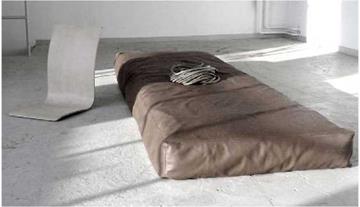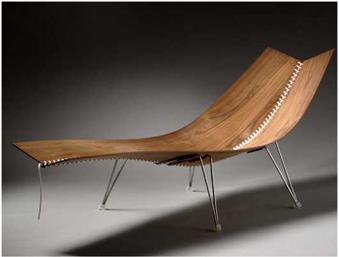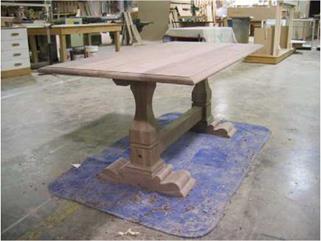For years, architectural theories were dependent on three interrelated terms—firmness, commodity, and delight. The Latin terms of origin firmitas, utilitas, and venustas are attributed to Vitruvius’s text, The Ten Books of Architecture, originally titled de Architectura, written in 79 CE Sir Henry Wotton translated the Latin terms in his 1624 treatise, The Elements of Architecture, as follows: "The end is to build well. Well building hath three conditions: firmness, commodity, and delight."4
From the phrase "firmitas, utilitas, and venustas" a theoretical framework emerges that is useful in guiding broad inquiry relative to furniture design. In this book, theories of furniture design are outlined accordingly:
Firmitas: Structural integrity, materials utilized, joinery, and tectonic composition (how furniture is made and held together)
Utilitas: Use and experience (perfor-mance, comfort, and how furniture functions and feels)
Venustas: Form, spatial organization, and aesthetics (how furniture looks, fits within space, and expresses meaning)
This model builds on an interpretation of Vitruvius and Wotton, but it also acknowledges the writings and designs of others who have contributed to a larger, more collective framework.
Keep in mind the links that theory has with time and place. Theory is connected to, and intertwined with, the spirit of the age from which it emerges. Furniture design supports this notion and needs to be considered in a spatial and temporal context. Ideas and perspectives about furniture embrace a range of issues that change over time and are influenced by culture, politics, economics, and place. Theories of furniture design consider the composition of parts (i. e., tectonics, materials, and structural integrity), function (i. e., ergonomics, comfort, and social use), and meaning (i. e., aesthetics and semantics) of built-form (Figures 5.5, 5.6, 5.7, and 5.8).
Firmitas
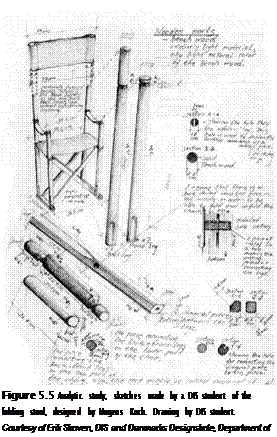 Firmness (firmitas) refers to the structural integrity and tectonic composition of furniture. Firmness is dependent on fabrication techniques, the quality of materials and workmanship, and the spatial relationships among the components and between the parts and the whole. Applied forces, such as lateral forces, challenge the physical integrity of furniture. Lateral forces, live loads, and gravity should be carefully considered when designing furniture. Lateral forces routinely cause joints and connections to fail. Braces, skirts, folds, and applied hardware serve to resist lateral forces and improve the structural integrity of furniture.
Firmness (firmitas) refers to the structural integrity and tectonic composition of furniture. Firmness is dependent on fabrication techniques, the quality of materials and workmanship, and the spatial relationships among the components and between the parts and the whole. Applied forces, such as lateral forces, challenge the physical integrity of furniture. Lateral forces, live loads, and gravity should be carefully considered when designing furniture. Lateral forces routinely cause joints and connections to fail. Braces, skirts, folds, and applied hardware serve to resist lateral forces and improve the structural integrity of furniture.
|
|
|
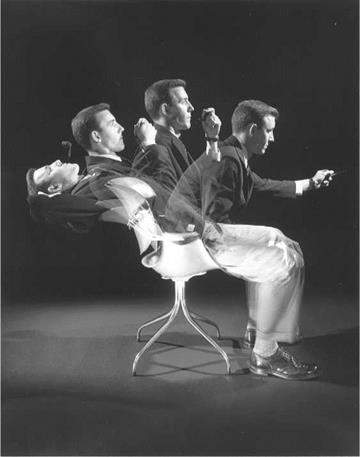

|
|
|
|
|
|
|
|

Consider the economy and structural integrity achieved in the deck chair (Figures 5.9 and 5.10) designed by the Danish architect Erling Christoffersen and fabricated by R0nne & Askou. The individual elements of the lounge are relatively flexible when unassembled, but as the contoured wood planes are drawn tight, the lounge transforms and becomes rigid.
A solid walnut trestle table (Figure 5.11) is detailed differently than a veneered table (Figure 5.12). This is so because lumber expands and contracts due to changes in humidity, while veneer demands a stable substrate. A solid lumber table must allow for expansion and contraction perpendicular to the wood’s grain or the design will fail.
Danish furniture designer B0rge Mogensen (1914-1972) was trained as a cabinetmaker. His Windsor-type armchair (1944) is remarkable in its structural integrity and the economy of its parts (Figure 5.13). As in most Windsor chairs, both legs and stretchers are turned with increased thickness where they receive smaller members. The back spindles are placed
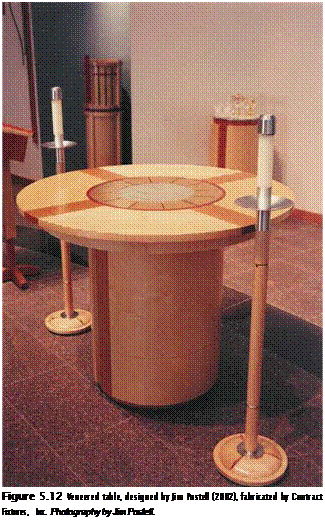 |
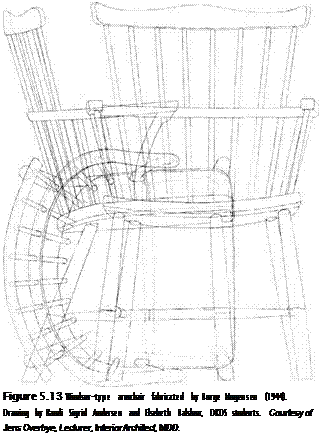 |
in compression, and the curved outer member is in tension as pressure is applied to the back. The open spindles are ideal solutions for outdoor settings, allowing breezes to pass through without blowing the chair over. The chair’s seat is generally made from solid wood, gently carved out to create a concave shape for comfort. The Windsor chair was originally called the stick chair, first appearing in the early 1700s. By the mid-1700s, the generic design was widely in use (Figure 5.14). There are many variations of the Windsor-type armchair, all of which are lightweight and durable.
Wood is not a uniform material. It has a range of physical characteristics and properties including grain, knots, growth rings, heartwood, sapwood, burls, and decay. These imperfections and irregularities will affect the structural characteristics of items made with wood. Some hardwoods are relatively soft, such as basswood, and some softwoods are relatively hard if allowed to grow slowly (as was once the case for southern yellow pine). Some woods adhere well with carpenter’s glue, such as Honduran mahogany, while others require polyurethane glue or epoxy glue to adhere freshly cut boards, such as ebony due to its density. Some woods are inherently stable (they don’t easily cup, warp, or bend after being worked by the jointer or planer), such as walnut, while other woods are dimensionally unstable, such as beech. Most hardwoods have an open cellular structure, such as red oak, but some hardwoods, such as white oak, have a closed cellular grain.
Wood has many properties. This demonstrates how important it is for both the designer and the fabricator to understand the unique characteristics of each species when specifying it in design. The cellular structure, the type of adhesive, the joinery, and the moisture content of lumber will affect the structural integrity of the design. Wood is one of several materials used to make furniture. The physical properties of other materials such as fabrics, metals, and plastics are equally important and are discussed further in Chapter 7.
Ideas can be expressed through details. Workmanship, structural integrity, and aesthetics are clarified through joinery. The word detail shares its origin with the word tailor, meaning a craftsperson who knows how to sew together individual pieces of fabric to make a complete set of clothes for the human body.5 The tailor, furniture designer, and furniture maker face similar challenges in how to join materials properly and consider human form and function in doing so.

